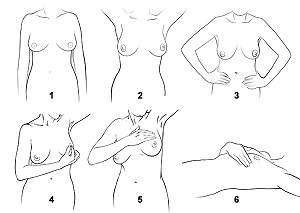
What is Breast Self-Examination?
Breast self-examination is a screening procedure by which a woman herself can detect any lumps, swellings, or distortions in her breasts. It can help identify breast cancer at an early stage. Breast cancer occurs during any age but is mostly seen in women above age 50.
Preparing for Breast Self-Examination
If you have never performed a breast self-examination before, it might be best to consult your doctor for instructions and a demonstration. You should perform breast self-examinations a week after your period ends, as hormone fluctuations occur during your menstruation that may cause swelling and tenderness of the breasts.
Procedure of Breast Self-Examination
It is important to detect any changes in the shape and size of the breasts, presence of inverted nipples, dimpling or puckering, or any asymmetrical structure.
To perform breast self-examination:
- Stand braless in front of a mirror with hands on your waist and observe for any changes in shape or lumps or swelling of your breasts.
- Raise your left arm straight above your head and place your right hand on the left breast. Start massaging with the pads of your fingers in a spiral manner starting from the nipple to the collar bone.
- Using your fingers, apply pressure from the side of your armpit to the bottom of the breast to detect for any swelling or lumps.
- Repeat this procedure while lying down, as the breast tissue spreads out to make it thinner.
- Performing this under the shower can be useful, as the soap lather helps your fingers glide smoothly over the skin.
- Apply varying levels of pressure with your finger pads at different points on your breast including near the nipple, chest and ribs.
- Take your time to perform a thorough and careful examination.
After Breast Self-Examination
Do not panic if you find a lump or swelling, as many abnormal findings are benign and include:
- Fibroadenoma
- Fibrocystic breast disease
- Mammary fat necrosis
- Intraductal papilloma
Breast self-examination findings that should be brought to the notice of your doctor include:
- A hard lump near your armpit
- An inverted nipple
- Itching, rashes or sores
- Swelling and pain with redness
- Discharge from the nipple that is white, yellow or bloody
To maximize the benefit of breast self-examination:
- Carry out breast self-examination once a month.
- Become familiar with the different areas of your breast so that it will easily help you to detect any changes.
- Make a note of your findings during examination.
Risks of Breast Self-Examination
This is a safe procedure but there are some risks that include:
- Anxiety and stress after finding a lump
- Relying solely on breast self-examination, as evaluation by your doctor for confirmation is also necessary.
